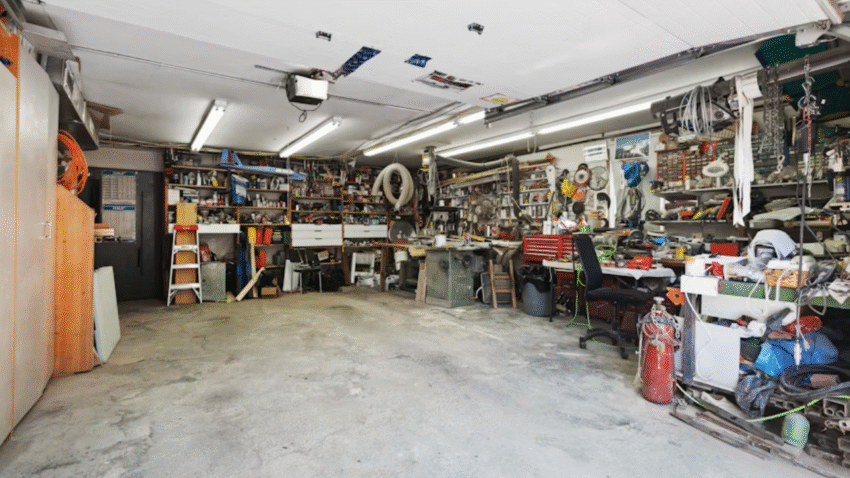Introduction
If you’ve noticed damp spots, musty odors, or peeling paint in your garage, moisture could be seeping through the concrete floor. Over time, this can lead to mold growth, surface deterioration, and damage to items stored in your garage. Learning how to seal garage floors against moisture is one of the best ways to protect your garage, keep it looking great, and extend the life of your flooring. With the right products and preparation, you can create a durable moisture barrier that lasts for years.
Why Sealing Garage Floors Matters
Concrete is a porous material, meaning it naturally absorbs moisture from the ground or air. Without a sealant, water can seep up through the floor or down from spills, causing:
- Mold and mildew growth – Creates unpleasant odors and potential health risks.
- Surface damage – Moisture can lead to cracking, flaking, or pitting in concrete.
- Ruined finishes – Paint, epoxy, and other coatings can peel or bubble.
- Damage to stored items – Moisture can warp wood, rust tools, and harm boxes.
- Reduced home value – A damaged garage floor looks unsightly to potential buyers.
By sealing your floor, you block moisture penetration, make cleaning easier, and improve your garage’s appearance.
Step-by-Step Guide to Sealing Garage Floors Against Moisture
1. Test for Moisture
Before sealing, determine how much moisture is present:
- Plastic sheet test – Tape a 2-foot square of clear plastic to the garage floor. Leave it for 24–48 hours. If condensation forms underneath, you have moisture intrusion.
- Calcium chloride test – A more accurate method available at hardware stores that measures moisture vapor emissions.
If you have severe moisture problems, address the source—such as drainage issues or groundwater seepage—before applying a sealant.
2. Gather Tools and Materials
You’ll need:
- Concrete cleaner/degreaser.
- Scrub brush or floor buffer.
- Pressure washer (optional for deep cleaning).
- Concrete patch or crack filler.
- Roller and extension pole.
- Paint tray.
- Protective gear: gloves, goggles, respirator.
- Chosen sealant (acrylic, epoxy, polyurethane, or penetrating sealer).
3. Clear and Clean the Garage
Remove all items from the floor. Sweep thoroughly to remove dust, dirt, and debris. If you see oil or grease stains, use a concrete degreaser to ensure proper sealant adhesion.
4. Repair Cracks and Holes
Moisture can enter through cracks, so patch them before sealing:
- Use a concrete crack filler for narrow gaps.
- Apply a patching compound for larger holes.
- Allow repairs to cure fully before proceeding.
5. Deep Clean the Floor
A clean surface ensures the sealant bonds properly:
- Scrub the floor with a concrete cleaner and stiff-bristled brush.
- Rinse thoroughly with clean water.
- Allow the floor to dry completely—this may take 24–48 hours, depending on weather.
6. Choose the Right Sealant
Different sealants offer varying levels of moisture protection:
- Acrylic sealers – Easy to apply, good for light protection, affordable.
- Epoxy coatings – Highly durable, excellent moisture barrier, decorative finish.
- Polyurethane sealers – Strong and abrasion-resistant, often used over epoxy for extra protection.
- Penetrating sealers – Soak into the concrete to block moisture from within.
For garages with heavy moisture issues, an epoxy or penetrating sealer is often best.
7. Apply the Sealant
Follow the manufacturer’s instructions for your chosen product:
- Pour sealant into a paint tray.
- Use a roller with an extension pole to apply an even coat across the floor.
- Work in small sections, keeping a wet edge to prevent lap marks.
- Apply a second coat if recommended, allowing proper drying time between coats.
8. Allow Proper Curing Time
Sealants need time to harden fully:
- Acrylic sealers: 24 hours before light use.
- Epoxy: 48–72 hours before driving on it.
- Polyurethane: Typically 48 hours.
Avoid heavy traffic until curing is complete to ensure maximum protection.
Common Mistakes to Avoid
- Skipping moisture testing
- Mistake: Applying sealant without knowing the moisture level.
- Solution: Always test first to choose the right product and prevent peeling.
- Not cleaning thoroughly
- Mistake: Sealing over dirt, dust, or oil.
- Solution: Degrease, scrub, and rinse thoroughly before sealing.
- Using the wrong sealant
- Mistake: Choosing a light-duty sealer for heavy moisture problems.
- Solution: Match the sealant type to your moisture level and garage use.
- Rushing drying and curing times
- Mistake: Driving on the floor too soon.
- Solution: Follow curing guidelines to prevent damage to the coating.
- Ignoring cracks before sealing
- Mistake: Sealing without filling gaps first.
- Solution: Patch cracks to create a uniform, moisture-proof surface.
Extra Garage Tips & Hacks
- Improve ventilation – Keep humidity low with a dehumidifier or fan.
- Add floor mats in high-traffic areas to protect the sealant.
- Reapply sealant every few years for continued protection.
- Related read: Check out our guide on sealing garage floor cracks to prevent damage.
Conclusion
Sealing your garage floor against moisture is a worthwhile project that can save you from costly repairs, protect your belongings, and improve your garage’s appearance. By testing for moisture, choosing the right sealant, and applying it correctly, you’ll create a barrier that keeps your garage floor dry and strong for years to come.
Pro Tip: Plan your sealing project for a dry weekend with mild temperatures to ensure the best curing conditions and long-lasting results.
